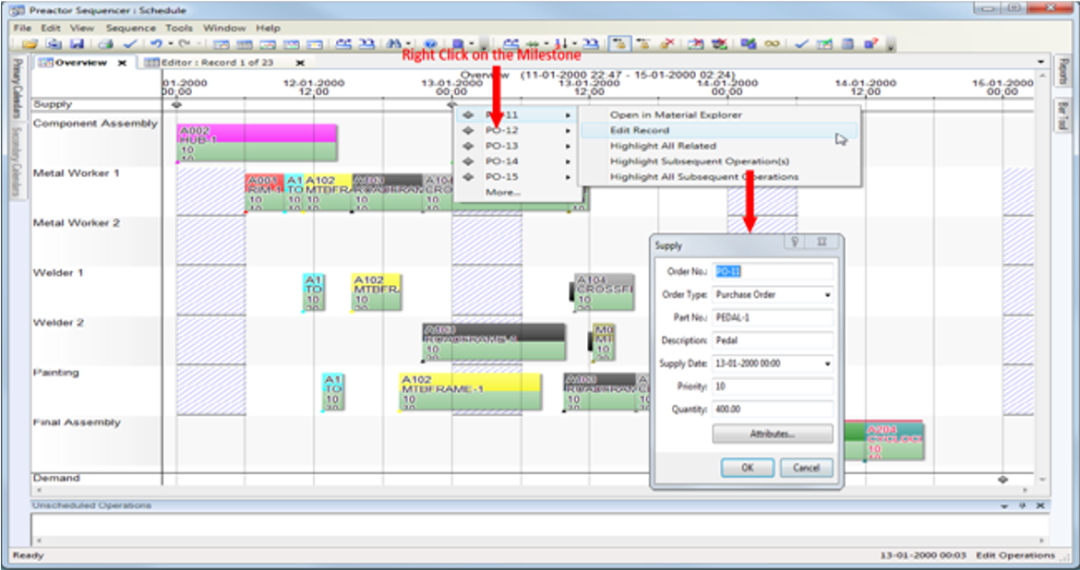"When the pandemic came, the original predicament was further aggravated. When manual scheduling and even deploying APS became ineffective, how much did the production scheduling change?"
Issues Linked Together in Manufacturing Production Scheduling
In production scheduling, many problems are interlinked, such as:
-
The business signs a large or VIP order, but the delivery time is only one week.
The production line is fully loaded, and the factory manager cannot give a definite answer: "There's no way, but I'll try my best."
After finally arranging a rush order, on-site staff say, "There's no way we're out of materials."
So, under the pressure of the factory manager, procurement can only respond, "There's no way we can only expedite with a premium."
The boss finds out that the profits have decreased year-on-year, and there's an inventory accumulation in the warehouse.
Finance also says, "There's no way; the payments are coming in slowly, and the working capital is also slowed down."
The above are common high-frequency issues in actual production management. Generally, factories use experienced supervisors to adjust schedules, trying to minimize the impact manually; more established factories will deploy an APS system, mitigating fluctuations with systematic efficiency improvements.
However, when the pandemic struck, the existing challenges were intensified, such as:
Material shortages due to production locations and disruptions in sea shipping.
Difficulties in resuming work leading to workforce shortages, production halts, and industrial chain interruptions.
In such an "impossible" situation, traditional manual scheduling and APS became ineffective.
Even giants like Foxconn faced similar challenges
As the world's largest manufacturer in the global 3C electronics (Computer, Communication, Consumer electronics) field – Foxconn also went through the above process, starting with manual scheduling by experienced supervisors, such as handwritten production records and manual calculations of material arrivals and wastage using Excel; to the later digitization of work orders, importing custom rule-based APS and related information systems.
However, after the pandemic, Foxconn found that the production schedules created by the rule-based APS did not meet customer delivery times or support factory line manpower allocation. This resulted in the production management department spending much time adjusting the production schedule.
So, the question arises: why did both these methods become ineffective?
First, let's look at manual scheduling:
1. Issue of legacy transition:
If senior employees leave, it's hard for companies to find suitable talent. Newcomers need training from seniors, which takes time. While the older generation hopes their expertise is passed on, younger ones prefer using systems.
2. Manual data issues:
All data is manually recorded, often leading to errors, or during scheduling calculations, a wrong keystroke can cause issues in the entire schedule.
Unforeseen Situations:
Emergencies and rush orders disrupt original plans, sudden machine malfunctions, personnel shifts, and delayed feedback from various departments.
4. Rescheduling is Laborious and Unrewarding:
Without APS, encountering emergency rush orders makes rescheduling both demanding and unrewarding. For instance, simply replacing one order with another in the original schedule—a straightforward swap—only affects one order. If the entire plan is pushed back, that seems the easiest solution. However, those who have been grassroots planners know the pain of this approach. All scheduling needs a complete overhaul, with delivery times also rescheduled, constantly adjusting, readjusting, and readjusting in Excel.
Now, looking at APS:
APS Cannot be Deployed in Bulk
Foxconn has dozens of factories, each producing different products. Therefore, the production logic varies, and APS needs to be imported into each factory separately—it cannot be imported in one go.
Lack of Agility
The APS algorithm is rigorous and based on constraint theories and intelligent calculations. Suppose the computed results significantly deviate from human-made plans. In that case, one must keep searching for the cause—whether it's an error in parameter settings, software issues, etc.

High User Requirements
The demands of the users are relatively high. Actual users must first have basic computer skills and understand the logic of ERP (Enterprise Resource Planning). Only then can they comprehend the reason of APS and identify errors in the APS algorithm during implementation, allowing further parameter adjustments.
Manual Scheduling is Better
Based on the third point, grassroots management personnel often feel: "Why use APS? I can work faster directly with Excel."
Uncontrollable Factors Emerge
Due to the pandemic situation, many circumstances became very critical and uncontrollable. APS alone couldn't resolve these issues.
What has JarviX achieved, and what benefits has it brought to Foxconn?
The situation changed once JarviX was introduced. So, what did JarviX accomplish, and what benefits did it bring to Foxconn?
Halved the Number of Personnel Previously: For ten products, there needed to be 20 production managers responsible for production scheduling (one for Central and one for Stage). This was reduced, and now only ten production managers are needed.
Saved 1.2 Million in Expenses: A production manager has a monthly salary of 10,000, which equates to an annual savings of 1.2 million in labor costs.
New Schedule in 10 Minutes: Although the number of production managers has decreased, it now only takes 10 minutes to produce a new production schedule. This is down from occupying 40% of the daily work hours to just 10%. The time saved can be spent on more valuable tasks.
Single System for Multiple Factories: JarviX can directly import production schedules from different factories with varied logic. It performs rapid computations on data volumes of up to 100TB and swiftly generates new schedules.
Great Scalability and Flexibility: For diverse small orders, or when there are new products, production lines, or equipment, there's no need to spend money again for custom deployments.










